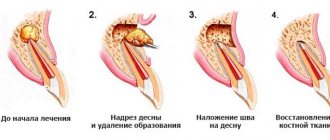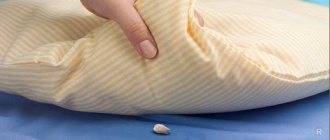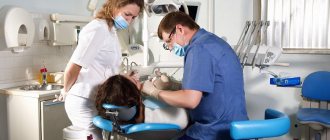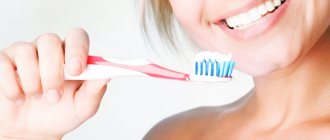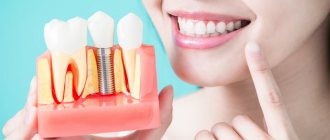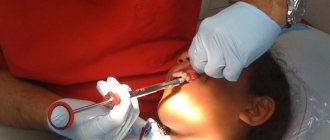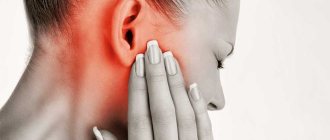What is frozen tooth like?
Depending on the purpose, anesthesia is performed local (numbing a specific area) or general (anesthesia).
The latter type is used when it is necessary to treat mental patients, patients with neurological disorders, with a large planned volume of intervention, in very fearful children and adults (rarely). Most often, local freezing is used, which can be combined with preliminary intake of sedatives to enhance the effect (valerian, tincture of peony, motherwort, etc.). Anesthesia of the upper jaw is somewhat different from the same procedure below. This is due to the structure of the bone. The upper jaw has a more porous structure, the penetration of the medicine during the injection is much easier and faster than when treating the lower teeth, to freeze which the anesthetic solution is injected deeper and further.
The lower jaw has a more dense structure, covered by masticatory muscles and ligaments, so it is usually impossible to freeze an individual tooth. Anesthesia is carried out at the exit point of the nerve trunks going to half of the jaw or to a certain part of it. Often not only the cheek is frozen, but also the lips and tongue. This is due to the proximity of the exit of all nerves to each other and the anesthetic that hits them.
Methods of pain relief used in dentistry
In dentistry, various types of anesthesia are used: both local and general. Methods of pain relief can be divided into medicinal and non-medicinal. Most often, painkillers and methods act on the same principle - the conductivity of the nerve canal is leveled, that is, the nerve impulse is extinguished.
Local anesthesia
This method is used by dentists in most cases. As a rule, having found out from the patient whether he has allergies to drugs, chronic diseases and other problems that affect the choice of anesthetic method, the doctor selects the most effective means to make the intervention painless. Currently, they most often resort to freezing the area of the procedure or administering an anesthetic drug by injection into the gum.
General anesthesia
In dentistry, general anesthesia is a fairly rare occurrence. Since this method has a significant impact on consciousness, all systems and organs of the body, doctors, unless absolutely necessary, try not to use general anesthesia. The average time spent under anesthesia is six hours. General anesthesia is used, during which the patient is unconscious, for major interventions. Basically, these are maxillofacial surgeries.
Nitrous oxide mask
Most often, this method is used to treat children and patients who cannot overcome their fear of the dentist in order to relieve discomfort. By inhaling nitrous oxide, the patient remains conscious, he breathes independently, reflexes and the ability to speak are preserved. This procedure is not used as anesthesia; the patient remains sensitive to pain, so this method is used in combination with another type of anesthesia.
Other methods
Other methods of anesthesia used in dentistry include non-drug methods of pain relief. Currently, anesthesia is performed using the following methods:
- audio analgesia - a psychotropic, distracting drug using a white noise generator,
- electroanalgesia - exposure to certain centers of the cerebral cortex with high-frequency electrical impulses,
- computer anesthesia - the supply of anesthetic is controlled by a computer,
- hypnosis - superficial pain relief through hypnotic influence.
Causes of toothache
Only a doctor can determine the exact and final reason why a toothache occurs. There are several most common problems that lead to tooth pain. These include:
- exacerbation of various dental diseases (for example, pulpitis, neuralgia, periodontitis, etc.);
- cracks on the tooth surface caused by mechanical means;
- caries (problems are caused by both the initial and already progressive stages of the disease);
- high sensitivity of enamel;
- damage to dentin (or enamel), which is very often observed after teeth whitening;
- inflammation of the periosteum;
- cyst of tooth or gum.
Freeze spray - what is it?
Based on the depth of action, anesthesia is divided into application and injection. Various gels or sprays are used to numb the needle injection site. The products are applied to the gum or cheek, and after 3-4 minutes an analgesic effect is achieved. It should be noted that only the superficial layer of the mucous membrane is frozen and when the needle moves deeper, unpleasant sensations still remain.
The freezing spray should not be used in children under 5 years of age or in patients with lung diseases (bronchial asthma), since reflex inhalation of the anesthetic can cause unpleasant and even dangerous consequences. Gels and sprays are used in the treatment of gums, to relieve pain from erosions and ulcers after injury or stomatitis, during difficult and painful teething.
Removing wisdom teeth
Anesthesia for wisdom tooth removal is no different from conventional means for treating other teeth. The doctor decides independently how to administer the medicine depending on the specific situation.
Most often, wisdom teeth are removed not because they are affected by caries, but because of their abnormal location. As a result, these teeth have the pathology dystopia or retention.
- Dystopia is the process of eruption of a wisdom tooth that is displaced towards the cheek or tongue.
- Retention is when a wisdom tooth has formed but has not erupted through the gums. In this case, the dentist makes an incision in the gum, removes the wisdom tooth and stitches the incision. Typically, such surgical procedures are performed under local anesthesia.
Taking analgesics for toothache
One of the most reliable ways to quickly relieve any pain, including toothache, is to take painkillers. You can use your home medicine cabinet and find the appropriate medicine there, or
and purchase the necessary medication. Below are proven and indeed fast-acting painkillers:
- ketones;
- Nurofen;
- ibuprofen.
These drugs are used quite often, since you can get rid of toothache with their help really quickly. If the above drugs are not available, you can take a simple, not so strong analgesic. It could be:
- analgin;
- aspirin;
- spazmolgon.
It must be remembered that the effect of all the above drugs is temporary, and after a few hours the problem may return.
If the pain becomes truly unbearable and you can’t bear it, you can open an ampoule of liquid lidocaine, moisten a cotton swab with the solution and apply it to the source of pain. Lidocaine will freeze all sensations in the place where it was applied. But when using this method, in no case should we forget about allergic reactions and possible individual intolerance.
We suggest you read: What to do if your wisdom tooth becomes inflamed
About pain relief
When using any painkiller, all the characteristics of the body are taken into account, including allergies, undergoing another course of treatment and chronic diseases. In addition, freezing itself is selected depending on the patient’s pain threshold, the severity of pain and the duration of the operation.
It becomes clear that the key to high-quality anesthesia is the correct choice of means. If the doctor carries out qualified work, the effect will quickly evaporate and no unpleasant sensations will remain.
Regarding how long it takes for a tooth to freeze or go away, most of the sensations will pass in half an hour. At the same time, you will be able to drive. After about two hours, the effect will disappear completely.
In some cases, to avoid side effects, doctors use freezing, which only reduces discomfort to the desired level, but does not completely remove it. To do this, use a lower dose or a different route of administration.
We invite you to familiarize yourself with the basics: painkillers – Zozhnik
How long does it take to freeze?
The effect of the product, applied externally to the gum or cheek, lasts several minutes. If an anesthetic is injected to treat the upper teeth, numbness lasts 1–2.5 hours. This depends on the depth of the injection, on the amount of medication administered and on the individual characteristics of the human body (age, metabolic rate, activity of the liver, kidneys).
Anesthesia in the lower jaw requires deeper penetration of the needle, so the anesthetic is removed from this area more slowly. The effect of freezing the lower teeth can last up to 3-4 hours, sometimes even longer. This is due to which tooth needs to be anesthetized (the further away the tooth, the more freezing is needed), how much anesthetic was injected into the tissue, and how actively it is removed by the body.
Rinse to relieve toothache
Many of those who have tried various ways to get rid of toothache at home recommend rinsing. This procedure is considered one of the safest and is recommended even by doctors. It is important to know that any rinsing is carried out only with warm infusions, decoctions or solutions. No matter how much you might want to cool a burning or shooting tooth, you shouldn’t do this. Rinsing with cold compounds can provoke the occurrence of flux and further suppuration.
The basis for rinsing can be varied; below are the most commonly used methods.
Soda rinses
- take warm, previously boiled water (1 tablespoon);
- regular soda is diluted in it (1 large spoon);
- if desired, you can add 1 drop of iodine (it disinfects inflamed areas well);
- It is necessary to rinse every hour.
Salt rinses
- take previously boiled water (1 tablespoon);
- table salt is dissolved in it (1 small spoon);
- mix everything and rinse the tooth often enough until the pain subsides.
The analgesic effect is explained by the fact that salt significantly reduces fluid pressure on the dentinal tubules. This, in turn, leads to the fact that the sensitivity of dentin tissue decreases and the pain subsides.
Quite often, when a tooth is inflamed, it is recommended to use sage, since it not only has an antibacterial and anti-inflammatory effect, but also has a soothing effect on the sore tooth. You can prepare the infusion for rinsing in the following way:
- take sage herb (1 large spoon);
- pour boiling water (1 tablespoon);
- the resulting mixture is infused (1 hour);
- rinse your mouth about 3 times a day.
From the same infusion, you can prepare a lotion. A piece of cotton wool should be moistened in the infusion and applied to the problem tooth. If you don’t have sage in the house, you can safely use chamomile instead, brewing it in the same way as above.
For inflamed pulpitis, you can prepare another herbal decoction for lotions. To do this you need:
- take plantain, sage, thyme and chamomile (1 large spoon each);
- everything is filled with warm water (1 tablespoon);
- placed in a closed container in a water bath (15 minutes).
We suggest you read: Cause of teeth grinding during sleep in adults
Next, the resulting decoction is cooled, filtered in a convenient way and applied to the affected area several times during the day.
There are long-proven methods with which you can temporarily calm a tooth that suddenly makes itself known. It happens that you don’t have the necessary tablets at home, you can’t go to the pharmacy, and rinsing does not bring the desired effect. In such extreme cases, you can remember about traditional medicine, which offers many ways to get rid of toothache. The funds that are supposed to be used are most likely found in everyone’s home.
Many claim that using this method you can soothe a sore tooth within 15 minutes. To do this, you need to take a piece of lard and place it between your cheek and the tooth causing trouble. This will bring temporary relief. And in order to freeze acute pain, you can take not fresh lard, but frozen lard from the refrigerator.
But, if there is visible damage to the tooth (if it has chipped or a mechanical crack has formed), you should not put fat into the damage; this can only aggravate the situation.
Thanks to a very large number of natural phytoncides, garlic has long been recognized as a powerful antimicrobial and antibactericidal agent. In cases of toothache,
in a variety of ways. Below are some of them:
- take one clove of garlic;
- peeled and cut in half;
- applied to the painful tooth with the cut side.
Next way:
- take grated onion (1 small spoon);
- grated garlic (1 small spoon);
- salt (1 small spoon);
- all ingredients are mixed until it forms a kind of porridge;
- The mixture obtained in this way is applied to the sore spot and pressed with a tampon (hold for 15 minutes).
It must be remembered that the composition of garlic is very concentrated, and since the mucous membrane of the internal oral cavity is quite sensitive, using garlic can cause a burn. Methods for eliminating toothache with the help of this plant must be used very carefully.
There are other methods offered by alternative medicine using garlic. For example, in case of severe pain, it is necessary to cut a plant clove. Rub it on your wrists (in the place where the pulse is felt). Then, the garlic is wrapped around the pulse point with a bandage. It is believed that the pain should subside very quickly.
You might also try a light massage.
- For 10 minutes you need to massage the ear, which is located on the same side as the sore tooth. It is necessary to massage the upper part and lobe until visible redness.
- On the hand that is on the opposite side of the painful tooth, you need to rub the place in the middle of the thumb and index finger. You need to rub for about 10 minutes (in a circular motion).
Even if the above methods were able to help and relieve aching or even acute pain, you need to understand that this effect will be temporary. If the problem has already arisen, it will definitely make itself known again. For this reason, you should consult a doctor as soon as possible. He will determine the true causes of pain and will be able to effectively eliminate them.
We suggest you read: How to soften tartar at home
How to quickly relieve toothache at home
You have a toothache, but you are far from the hospital or is it closed at that hour? Provide first aid to yourself. There are many reasons for pain, so don't rest when you feel better. Go to the doctor immediately to avoid complications: purulent inflammation, fistulas on the gums, headaches. There are many ways to quickly get rid of pain:
- Take medications.
- Rinse your mouth with various means.
- Pain relief with traditional recipes.
Medicines
The most affordable pain reliever for toothache is a pill taken on time. It will help relieve pain and calm inflammation. There are medications that are recommended for use by children during pregnancy. Antibiotics are often prescribed by the dentist for suppuration after tooth extraction. Make sure there are dental drops on the shelf of your home medicine cabinet.
Typically, to reduce discomfort after treatment, the patient is recommended to apply warm compresses to the numb area. There is no need to warm the cheek if a tooth has been removed, but applying a warm handkerchief ironed with an iron is quite acceptable. Blood vessels dilate under the influence of heat, the activity of processes increases, and anesthesia passes faster.
It is impossible to remove the freeze with any medicine. Until the substance introduced into the tissue dissolves and resolves, the numbness will not go away. How to remove frost at home: only a warm drink or a warm compress on the injection area can somewhat reduce the discomfort and speed up the process.
What should I do to make the anesthesia wear off?
The anesthesia will go away faster if you do a massage.
In order to avoid undesirable consequences, you should ask your doctor in advance how to remove the frost after dental treatment.
The specialist should explain that in order for the painkiller to wear off as quickly as possible, you need to follow a few simple rules:
- A few hours before visiting the dentist, it is not recommended to eat heavy food or drink alcohol. Do not take any medicines unless they have been prescribed to you by your doctor.
- In order for the frost to go away faster after a simple dental procedure, it is recommended to drink something warm, as well as massage the numb area.
- After a serious intervention (pulp opening, drainage, etc.), you should not drink or touch this area. Stop drinking for an hour after the intervention, and do not eat food for four to five hours.
After dental treatment, you should not drink for several hours.
If the effect of the painkiller does not go away for a long time, then you need to visit a doctor as soon as possible. It is possible that a nerve was damaged during the intervention. In this case, physical therapy is performed, and a consultation with a neurologist may be required.
Freezing during pregnancy
Dental anesthesia can be administered to pregnant women starting from the second trimester. In this case, the most modern means that are safe for the fetus should be used.
Of course, any dentist recommends dental treatment in advance of pregnancy. If you still need to treat your teeth, then it is optimal to do this in the second trimester of pregnancy. Of course, if necessary, the doctor will provide first aid to the patient at any stage of fetal development, but as a result, there are certain risks.
Tooth freezing for a pregnant woman is carried out using the most modern means that do not contain adrenaline, which can cause an increase in blood pressure and contraction of the uterus in the patient. Dental treatment is carried out using non-toxic drugs, traumatic interventions are avoided, and in some cases the procedure is carried out in a hospital setting.
Anesthesia drugs
Medicines for local anesthesia do not pass through the placenta and do not affect the development of the baby in any way. That is why they can be used in the treatment of pregnant women. But general anesthesia and drugs acting on blood vessels should be avoided.
Dentists actively use painkillers such as ultracaine and alfacaine. They freeze teeth well and are quickly eliminated by the body. Local effects on tissues do not affect the course of pregnancy in any way.
We invite you to familiarize yourself with Composite veneers - quick correction of the dentition
Drugs that are not recommended during pregnancy include lidocaine. In some cases, it causes muscle spasms and low blood pressure, and this condition can be critical for the health of the expectant mother. It is better not to take risks and use proven anesthetics that will definitely not affect the child in any way.
Pregnant women are contraindicated in medications containing adrenaline. This hormone can cause uterine contractions and premature birth. This also includes drugs that can lead to muscle spasms. Typically, these drugs are not used in modern dental clinics, but it would be a good idea to ask your doctor again.
Dental anesthesia during breastfeeding
Many mothers are afraid to go to the dentist and have their teeth treated while breastfeeding, but in vain. There is nothing wrong with such a procedure. The effect of the injected substances is mainly directed at the injection site, it is not injected into the blood, so even for the mother the toxicity of the drugs is minimal. If you feed your baby before visiting the doctor and prepare milk in advance for the next feeding, then by the time the mother wants to breastfeed again, the remaining anesthetic in the blood will be in negligible concentrations.
Treatment or removal of teeth is an unpleasant procedure and pain relief is simply necessary. A well-carried freezing lasts for several hours; during medical procedures, the patient does not feel any pain at all. The use of freezing in dentistry is quite extensive; it is used for children aged 3–4 years. After the procedure, you should remember that numb soft tissues can be easily injured during eating, so the doctor recommends waiting until the freezing wears off.
Types of anesthesia
Baby teeth, like permanent teeth, have nerves and can hurt! Depending on the depth of tissue damage, different types of anesthesia can be used for treatment.
Children are usually given one of three types of anesthesia: application, infiltration or conduction.
One of the easiest to influence the body is a spray or gel, which works only on the surface of the oral mucosa. Such application anesthesia is often performed when removing a mobile baby tooth or to reduce sensitivity before conducting conduction or infiltration anesthesia.
We suggest that you familiarize yourself with Antibiotics for herpes stomatitis
In pediatric dentistry, as in adult dentistry, the method of infiltration anesthesia is often used - this is an injection. Its effect is aimed at blocking the nerve endings of the area that requires treatment. The latest generation of drugs begin to act instantly, and the dentist can begin treatment almost immediately. Infiltration anesthetic substances block pain.
Conduction anesthesia is considered to be the most powerful, since it affects the nerve branch of a large area of the jaw. This type of anesthesia is used when it is necessary to treat several teeth nearby, and only if infiltration anesthesia is not enough.
After treatment, the effect of the anesthetic lasts for some time, so it is recommended to refrain from eating immediately after the procedure and ensure that the child does not chew the inside of the cheek.
When we are talking about young children or a large amount of restorative work in the oral cavity, for example, treatment of caries on 5–13 teeth at the same time, the child may be recommended medicated sleep or, in medical terms, conditions of deep sedation, that is, anesthesia.
Children are put under anesthesia using Sevoran gas.
This method is considered the most modern, safe and preferable today, since the gas is quickly eliminated from the body without causing complications.
https://www.youtube.com/watch?v=eLnNkB6VYpw
How this happens: the substance Sevoflurane is administered through a mask, the child takes a few breaths and falls asleep. When treating with Sevoran, a team of specialists works. Among them there is always an anesthesiologist-resuscitator who monitors general indications: blood pressure, heart rate and body temperature. It is this doctor who is responsible for the child’s condition throughout the entire treatment.
As soon as the gas supply stops, the child awakens and returns to consciousness almost immediately. Awakening is also monitored by an anesthesiologist.
Remember that the anesthesiologist-resuscitator gives permission for anesthesia only after careful preparation and subject to correct test results.
